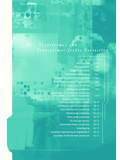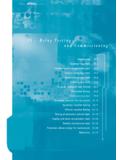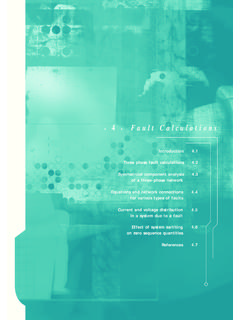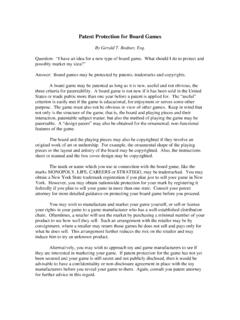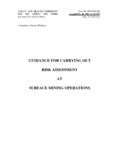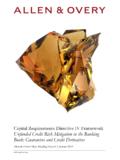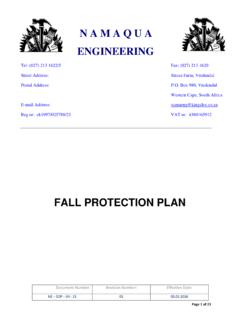Transcription of 20 Protection of A.C. Electrified Railways - fecime.org
1 Single-phase thermal backup substation of classical system 20 Protection of INTRODUCTIONMany regional, urban and high-speed inter-urban railnetworks worldwide are Electrified , to provide themotive power for trains (Figure ). The electrification system serves as the contact interfacefor current collection by each train, and in electrifiedrailways as the means to distribute power. In general,one of two philosophies are followed: an overheadcatenary above the track, with power collection by apantograph; or conductor-rail electrification, withcurrent collection via contact shoes on a surface of aspecial metallic conductor laid close to the running latter arrangement is most commonly used for , while the former arrangement is used for traction.
2 Some rail routes have dual overheadand conductor-rail electrification to facilitate routesharing by different rail catenaries are generally considered to be safer,as they are above the track, out of reach of rail personneland the public. They are the only way in which a tractionfeed at high voltages can be engineered. They provide asingle-phase supply with a voltage in the range of11kV-50kV with respect to the running rails, and 3kV catenaries are predominant in some 20 Protection of RailwaysNetwork Protection & Automation Guide 353 Figure : Modern high-speed electricinter-urban traincountries. When a conductor-rail system is used, thesupply voltage is generally 600V to 1700V Chapter covers Protection associated with HVoverhead catenary electrification.
3 Due to the natureof many rail routes and the limited electrical clearances(especially where an existing non- Electrified route is tobe Electrified ), catenary faults are common. A typicalfault rate is one fault per year per route kilometre oftrack. The relatively high fault rate, coupled with thehigh mechanical tension in the contact wire (typically 6-20kN) demands fast fault clearance. Should a fault notbe cleared quickly, the conductors that form the catenarymay break due to intense overheating, with theconsequent risk of further severe damage caused bymoving trains and lengthy disruption to train Protection PHILOSOPHYThe application of Protection to electrical powertransmission schemes is biased towards security whilstensuring dependability only for the most severe faults withinthe protected circuit.
4 Being too adventurous with theapplication of remote back-up Protection should be avoided,since the consequences of unwanted tripping are the case of Electrified Railways , there is a highprobability that sustained electrical faults of any type(high resistance, remote breaker/ Protection failure etc.)may be associated with overhead wire damage or afaulty traction unit. Fallen live wires caused bymechanical damage or accident represent a greatersafety hazard with Railways , due to the higher probabilityof people being close by (railway personnel working onthe track, or passengers). Traction unit faults are a firehazard and a safety risk to passengers, especially intunnels.
5 For these reasons, there will be a bias towardsdependability of back-up Protection at the expense ofsecurity. The consequences of an occasional unwantedtrip are far more acceptable (the control centre simplyrecloses the tripped CB, some trains are delayed whilethe control centre ensures it is safe to reclose) than theconsequences of a failure to trip for a fallen wire or atraction unit CLASSICAL SINGLE-PHASE FEEDINGC lassical single-phase railway electrification has beenused since the 1920 s. Earlier systems used low frequencysupplies and in many countries, electrification systemsusing 162/3Hz and 25Hz supplies are in use.
6 The cost ofconversion of an extensive network, with a requirementfor through working of locomotives, throughout thenecessary changeover period, is usually from Western Europe and with the influencespreading worldwide, single-phase electrification atthe standard power system frequency of 50/60Hz, hasbecome the standard. Figure illustrates classical25kV feeding with booster transformers (BT). Thebooster transformers are used to force the tractionreturn current to flow in an aerially mounted returnconductor, anchored to the back of the supporting masts(Figure ). This arrangement limits traction currentreturning through the rails and earth in a large cross-sectional loop, thereby reducing electromagneticinterference with adjacent telecommunication step-down transformer connected phase to phaseacross the Utility grid is generally the source of thetraction supply.
7 The electrical feed to the train is via theoverhead catenary, with the return current flowing viathe rails and then through the return the running rails are bonded to earth at regularintervals, they are nominally at earth potential. A single-pole circuit breaker is all that is required to disconnectthe supply to the catenary in the event of a Classical System - Feeding DiagramIn practice, single-track railway lines are rare, and two orfour parallel tracks are more common. The overhead lineequipment is then comprised of two or four electricallyindependent catenaries, running in parallel. Figure + 20 Protection of Electrified RailwaysNetwork Protection & Automation Guide 354 Return conductorCatenaryRailsBTSupplytransforme rBT25kV(nominal)Path of traction currentBT: Booster transformerFigure : Classical 25kV feeding withbooster transformersFigure : Classical overhead line constructionshows the feeding diagram for a typical two-trackrailway using a classical electrification infeed to the tracks in the northbound direction isvia grid transformer T1 at the Feeder Station (FS).
8 Thepower is then distributed via catenaries A and B abovethe northbound and southbound tracks. At intervals, it isusual to parallel the two catenaries at paralleling/sub-sectioning substations, as illustrated in the Figure current can then flow in the parallel paths, whichreduces the impedance to the load and hence the linevoltage drops. As the substation terminology implies, theprovision of circuit breakers for each of the outgoingfeeds to the catenaries also allows subsectioning theability to disconnect supply from sections of catenary, inthe event of a fault, or to allow for maintenance. For afault on catenary A in Figure , circuit breakers A atthe feeder station and at SS1 would be tripped to isolatethe faulted catenary.
9 The supply to the healthy sectionsof catenary B, C, D, E and F would be infeed from T1 generally feeds only as far as thenormally open bus section circuit breaker (BS2) at themid-point substation (MPSS). Beyond the MPSS there is amirror image of the electrical arrangements T1 to BS2shown in Figure , with the remote end feeder stationoften 40-60km distant from T1. BS2 must remain openduring normal feeding, to prevent Utility power transfervia the single-phase catenary, or to avoid parallellingsupplies that may be derived from different phase pairs ofthe Utility grid Phase A-B at T1, and B-C at the nextFS to the north.
10 The same is true for BS1, which normallyremains open, as the T1 and T2 feeds are generally fromdifferent phase pairs, in an attempt to balance the loadingon the three phase Utility grid. The neutral section (NS)is a non-conducting section of catenary used to providecontinuity of the catenary for the pantographs of motivepower units while isolating electrically the sections oftrack. While only two (one per rail track) are shown forsimplicity, separating the tracks fed by T1 and T2 at theFeeder Station, they are located at every point whereelectrical isolation facilities are Classical System - Protection PhilosophyThe grid infeed transformers are typically rated at 10 to25 MVA, with a reactance of around 10% (or whenreferred to the 25kV winding).

